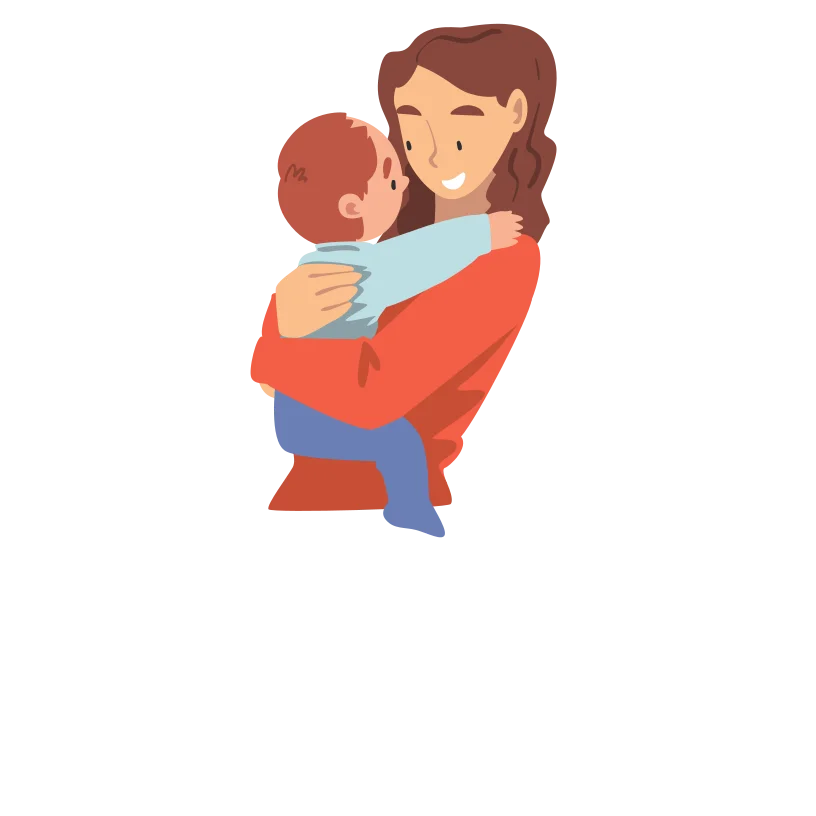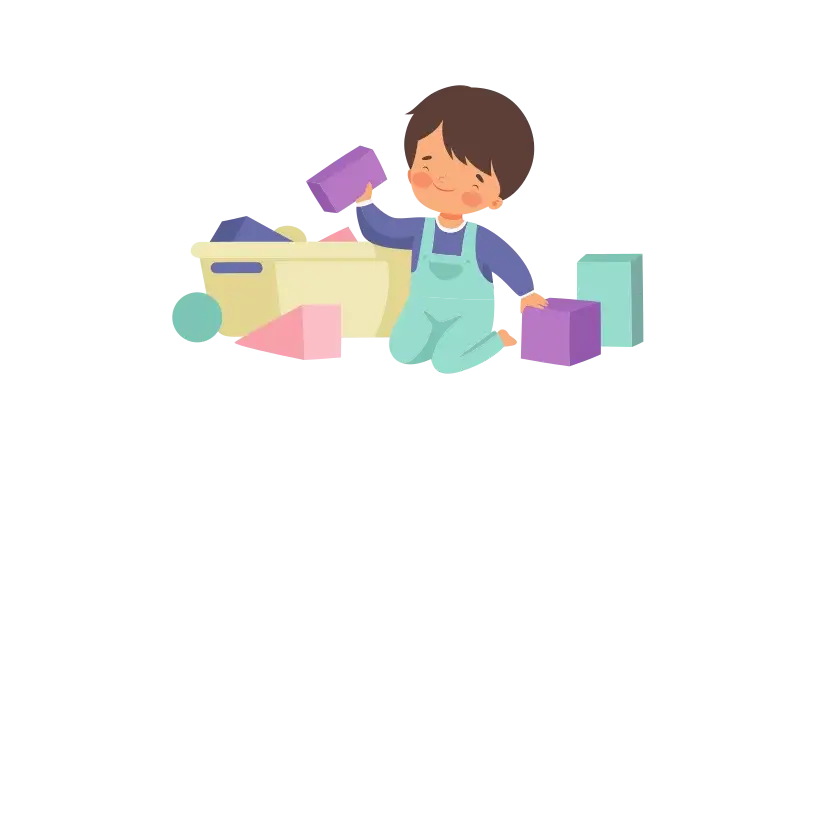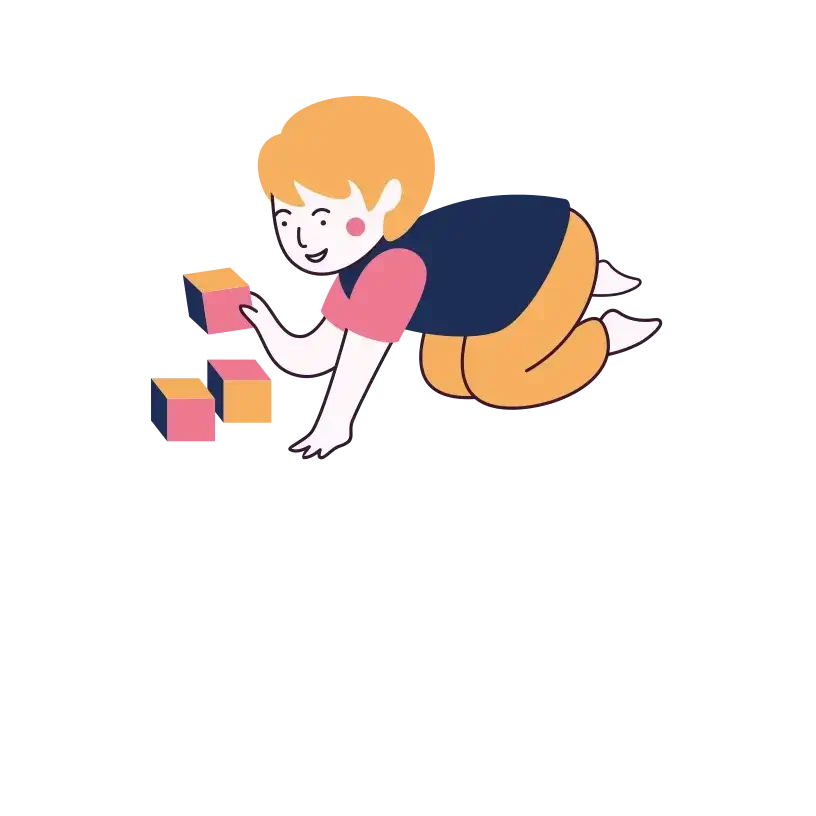Menu

At around 16 months old, your child’s sense of self develops, and they may perceive the world as revolving around them. This perspective, though natural, can lead to behaviours like asserting themselves when another child tries to take their favourite toy. Additionally, they might experience separation anxiety as they become more aware of being separated from you.
To help them cope with these challenges, providing reassurance, maintaining routines, and gradually exposing them to brief separations can be beneficial strategies. It’s all part of their normal development as they navigate their growing understanding of themselves and their place in the world.
At 16 months old, your child’s newfound mobility means they’re likely always on the move, and it might feel like you’re constantly chasing after them! Some toddlers may even start to run in short bursts, adding another layer of excitement and challenge to keeping up with them.
It’s crucial to stay vigilant and closely watch them, especially in environments where potential hazards, like garden ponds or paddling pools, could pose a danger.
Since toddlers are naturally curious and lack a sense of danger, it’s important to be proactive in keeping them safe by removing or securing any potential risks and supervising them closely as they explore their surroundings.
At 16 months old, your little one’s growth continues steadily. The typical weight ranges from about 17 to 28 pounds for girls, while boys may weigh anywhere from 18½ to 29 pounds. In terms of height, girls usually measure between 28 to 33 inches tall, while boys range from 29 to 33½ inches.
Remember, every child grows at their own pace, so as long as your toddler is healthy and thriving, there’s no need to worry about the numbers on the scale or the measuring tape. Keep providing them nutritious meals, plenty of love, and opportunities for exploration and play to support their overall development.
As your child approaches the teething milestone around 16 months, it’s important to recognise the signs of this developmental stage. Look out for indicators such as swollen and red gums, increased fussiness, flushed cheeks, drooling, and a tendency to suck on fingers or fists.
While these teething symptoms are usually temporary, seeking guidance from a healthcare professional is advisable if your child experiences persistent discomfort that interferes with sleep.
To help ease your 16-month-old teething discomfort, consider offering soothing options such as chilled fruits, vegetables, sugar/salt-free rusks, or a teething ring. Additionally, gently massaging their gums with a clean finger can provide relief. While teething typically doesn’t lead to severe illness, it’s essential to consult your doctor if your child develops a fever or diarrhea.
Tantrums or screaming can start as early as 12 months and continue until a child ages four. While reasons for tantrums vary, common triggers include frustration from not understanding or disliking something, exhaustion, hunger, and the desire for control, especially during transitions like bath, meal, or bedtime. To handle tantrums effectively:
At 16 months old, your child should typically have three meals and two snacks daily. Most doctors recommend around 1,000 calories per day for toddlers, illustrating roughly 40 calories for each inch of their height. It’s common for toddlers to have varying appetites from day to day, and that’s completely normal. They’re usually good at self-regulating their food intake.
Remember that a serving size for them is about one-fourth the size of an adult portion.
If your toddler isn’t using utensils, encourage them to practice eating with a spoon and fork.
Your child can enjoy a variety of foods, so aim to include a selection from all the food groups your family eats to ensure each meal is nutritious and balanced. Make every bite count by offering a diverse range of foods that provide essential nutrients.
Ensure your child receives a serving of animal foods like milk, dairy, eggs, meat, fish, or poultry daily, along with legumes such as chickpeas, lentils, peas, or nuts, and include orange or green vegetables and fruits. Incorporating a small amount of oil or fat into their meals can provide additional energy.
Choose healthy options like fresh fruit for snacks to keep your child’s energy levels up between meals. You’re supporting your child’s growth and development by providing a variety of nutrient-rich foods.
Provide a diverse array of foods: Introduce a wide variety of foods from all food groups, including fruits, vegetables, proteins (such as lean meats, poultry, fish, beans, and tofu), grains (opt for whole grains when possible), and dairy or dairy alternatives.
Foster independence in eating: Support your child’s autonomy by offering finger foods that are easy for them to grasp, like small fruit pieces, cooked vegetables, and protein cubes. Encourage using utensils and allow them to practice self-feeding, even if it leads to messiness. This helps refine their fine motor skills and promotes independence.
Respect their appetite cues: Recognise that toddlers have small stomachs, so a portion appropriate for them is smaller than an adult’s. Offer smaller, more frequent meals and snacks throughout the day to meet their energy needs, and don’t be discouraged if their intake varies. A typical 16-month-old should consume three meals and two snacks daily in addition to the recommended two 8-ounce cups of whole milk.
Share meals together: Cultivate a positive mealtime environment without distractions like TV or screens. Encourage conversation, model healthy eating behaviours, and make mealtimes social, enjoyable, and unhurried.
Practise patience: Toddlers may eat slowly or go through phases of rejecting certain foods. Exercise patience and avoid pressuring them to eat. Continue offering various nutritious options in different textures and flavours, and consult with your paediatrician if you have any concerns about your toddler’s eating patterns.
At 16 months old, your child typically needs 11 to 14 hours of sleep each day. They may begin transitioning to just one nap per day, which could lead to adjustments in your daily schedule. The morning nap is typically the one to go; the afternoon nap becomes longer, or the bedtime shifts slightly earlier. Fortunately, this transition usually occurs naturally.

Your child’s visual capabilities evolve significantly from 1 to 2 years old. By age 2, they can notice intricate details and their depth perception becomes well-developed. As a caregiver, you play a crucial role in providing pleasant and visually stimulating environments.
Engage your toddler with colourful picture books, interactive toys, and outings to varied settings like the park, grocery store, or a friend’s house, where they can explore and observe different sights.

By around 16 months, toddlers are not only comprehending simple commands but also starting to recognise familiar objects and the names of family members. While their language skills are still developing, they’re becoming more adept at nonverbal communication.
They enjoy engaging with sounds and laughter through children’s songs or playing with friends in the park. Encouraging their love for auditory experiences can further support their language development and overall cognitive growth.

As toddlers refine their language skills, they become more vocal about their food preferences. Introducing a variety of tastes and smells during meals or outings can help them expand their palate.
It’s common for toddlers to reject new foods initially, but consistent exposure can eventually lead to acceptance. Encourage descriptive language during meal times to help them articulate their experiences and develop an appreciation for different flavours and aromas.

Toddlers may seem constantly on the move, they still crave affection and reassurance from their caregivers. Show your love through cuddles and kisses, reinforcing their sense of security and emotional well-being.
Additionally, ensure your home is childproofed to create a safe environment for exploration. Address behaviours like hitting by teaching alternative ways to express emotions and setting clear boundaries when necessary, nurturing their social and emotional development alongside their physical exploration.

Your child’s visual capabilities evolve significantly from 1 to 2 years old. By age 2, they can notice intricate details and their depth perception becomes well-developed. As a caregiver, you play a crucial role in providing pleasant and visually stimulating environments.
Engage your toddler with colourful picture books, interactive toys, and outings to varied settings like the park, grocery store, or a friend’s house, where they can explore and observe different sights.

By around 16 months, toddlers are not only comprehending simple commands but also starting to recognise familiar objects and the names of family members. While their language skills are still developing, they’re becoming more adept at nonverbal communication.
They enjoy engaging with sounds and laughter through children’s songs or playing with friends in the park. Encouraging their love for auditory experiences can further support their language development and overall cognitive growth.

As toddlers refine their language skills, they become more vocal about their food preferences. Introducing a variety of tastes and smells during meals or outings can help them expand their palate.
It’s common for toddlers to reject new foods initially, but consistent exposure can eventually lead to acceptance. Encourage descriptive language during meal times to help them articulate their experiences and develop an appreciation for different flavours and aromas.

Toddlers may seem constantly on the move, they still crave affection and reassurance from their caregivers. Show your love through cuddles and kisses, reinforcing their sense of security and emotional well-being.
Additionally, ensure your home is childproofed to create a safe environment for exploration. Address behaviours like hitting by teaching alternative ways to express emotions and setting clear boundaries when necessary, nurturing their social and emotional development alongside their physical exploration.

Your child may form a strong emotional bond with a stuffed animal, blanket, or another comforting object. This attachment gives them a sense of security and familiarity, especially during stress or separation from caregivers.

By 16 months, many toddlers are proficient walkers, gaining confidence in their ability to navigate their environment independently. They may still wobble or occasionally fall, but their strides become more stable with practice.

With their newfound mobility, toddlers become more adventurous explorers. They may climb onto furniture, stairs, or other objects to satisfy their curiosity and discover new perspectives of their surroundings.

Toddlers love to mimic adults, and at 16 months, they may eagerly attempt to assist with simple household tasks. They may imitate sweeping, wiping surfaces, or putting toys away, albeit with limited effectiveness.

Building towers with blocks is a favourite activity that promotes fine motor skills, hand-eye coordination, and spatial awareness. At 16 months, toddlers may enjoy stacking blocks vertically and knocking them down, delighting in the cause-and-effect relationship.

As toddlers explore new tastes and textures, they may develop preferences and aversions to certain foods. This newfound selectivity is a normal part of their development as they assert their independence and express their likes and dislikes.

While separation anxiety is common in younger toddlers, many 16-month-olds become more secure in their relationships with caregivers and more comfortable with brief separations. However, some may still experience occasional clinginess or distress when separated from familiar faces.

Toddlers are naturally drawn to music and may spontaneously dance or sway to the rhythm of songs. Dancing to music not only brings joy but also promotes physical coordination, rhythm perception, and self-expression.

With improved coordination and balance, some toddlers may experiment with different body movement methods. They may trot or prance around, exploring the capabilities of their newfound mobility and expressing their playful energy.

It’s normal to compare your child’s development with a child of a similar age or even with older siblings, wondering why they may be smaller or taking longer to reach milestones like talking or walking. However, it’s important to remember that each child develops at their own pace and on their unique timeline. Your toddler may excel in certain areas while lagging in others, and that’s perfectly normal.
When receiving unsolicited advice from well-meaning individuals, it’s best to take it with a grain of salt. Instead, consider discussing your concerns about your 16-month-old’s development with their healthcare provider for personalised guidance and support.

Your child may form a strong emotional bond with a stuffed animal, blanket, or another comforting object. This attachment gives them a sense of security and familiarity, especially during stress or separation from caregivers.

By 16 months, many toddlers are proficient walkers, gaining confidence in their ability to navigate their environment independently. They may still wobble or occasionally fall, but their strides become more stable with practice.

With their newfound mobility, toddlers become more adventurous explorers. They may climb onto furniture, stairs, or other objects to satisfy their curiosity and discover new perspectives of their surroundings.

Toddlers love to mimic adults, and at 16 months, they may eagerly attempt to assist with simple household tasks. They may imitate sweeping, wiping surfaces, or putting toys away, albeit with limited effectiveness.

Building towers with blocks is a favourite activity that promotes fine motor skills, hand-eye coordination, and spatial awareness. At 16 months, toddlers may enjoy stacking blocks vertically and knocking them down, delighting in the cause-and-effect relationship.

As toddlers explore new tastes and textures, they may develop preferences and aversions to certain foods. This newfound selectivity is a normal part of their development as they assert their independence and express their likes and dislikes.

While separation anxiety is common in younger toddlers, many 16-month-olds become more secure in their relationships with caregivers and more comfortable with brief separations. However, some may still experience occasional clinginess or distress when separated from familiar faces.

Toddlers are naturally drawn to music and may spontaneously dance or sway to the rhythm of songs. Dancing to music not only brings joy but also promotes physical coordination, rhythm perception, and self-expression.

With improved coordination and balance, some toddlers may experiment with different body movement methods. They may trot or prance around, exploring the capabilities of their newfound mobility and expressing their playful energy.

It’s normal to compare your child’s development with a child of a similar age or even with older siblings, wondering why they may be smaller or taking longer to reach milestones like talking or walking. However, it’s important to remember that each child develops at their own pace and on their unique timeline. Your toddler may excel in certain areas while lagging in others, and that’s perfectly normal.
When receiving unsolicited advice from well-meaning individuals, it’s best to take it with a grain of salt. Instead, consider discussing your concerns about your 16-month-old’s development with their healthcare provider for personalised guidance and support.
Encourage play and social interaction: At this stage, toddlers often engage in parallel play, playing alongside but not necessarily with other children. Over time, they learn to cooperate and interact during play. Arrange playdates with peers and seize every opportunity to play with your child to promote their development and strengthen your bond.
Provide simple toys and safe objects: Toys like blocks, plush toys, and puzzles, as well as household items such as unbreakable containers and wooden spoons, aid in developing your child’s imagination, hand-eye coordination, and fine motor skills. Remember, expensive toys aren’t necessary; often, children find joy in everyday objects like cardboard boxes.
Establish routines: Consistency in your toddler’s daily schedule, including bedtime, naps, and meal/snack times, helps them learn rules and expected behaviours. Predictability provides a sense of security and may help them develop healthy habits.
Set boundaries: As toddlers become more curious and adventurous, it’s essential to establish physical and behavioural boundaries to ensure their safety. Child-proof your home and redirect their attention when they approach potentially dangerous situations. While it may be challenging to anticipate every move, the effort is worthwhile for their safety.
Introduce nursery rhymes: Singing or reciting nursery rhymes with your toddler provides entertainment and aids their cognitive development. Learning rhymes familiarises them with sound structures and letters, laying the foundation for early literacy skills such as reading. Regular repetition reinforces these connections and supports language development.
Establish a daily routine of three meals and two to three nutritious snacks, understanding that your toddler may occasionally eat less or skip meals altogether. While this can be challenging, respecting your child’s cues for hunger and fullness is important.
Toddlers often communicate when they’re full by pushing food away, closing their mouths, turning their heads, using hand gestures, or making sounds. Avoid insisting that children eat when they’re not hungry, as honouring their appetites and preferences is essential.
Young children may display aggressive behaviour when frustrated or unable to control their environment. This can manifest as kicking, biting, or hitting when they don’t get their way. To address this, it’s important to lead by example, establish clear expectations and boundaries, and reinforce positive behaviour through praise.
At 16 months old, toddlers typically demonstrate fine motor skills such as turning pages, using both thumb and fingers together, stacking two blocks, pointing at objects, placing or removing objects from containers, identifying and placing simple shapes into puzzles, and engaging in spontaneous scribbling.
To encourage your child’s motor skills, provide books for turning pages, toys for grasping and stacking, activities for pointing, containers for object manipulation, puzzles for shape recognition, and opportunities for spontaneous scribbling.
Fortunately, there isn’t a recognised sleep regression at 16 months. However, if you notice any changes in your child’s sleep patterns around 16 months, it may be due to factors like teething and developmentally appropriate separation anxiety.
On average, a 16-month-old typically takes one to two naps per day. Many toddlers transition from two naps to one nap around this age, but some may still require two shorter naps to meet their sleep needs. It is important to observe your child’s sleep patterns and adjust their nap schedule based on their needs.
At this stage, your child is beginning to navigate a wide range of emotions, but they’re still learning to process them. Even moments of happiness can quickly become tantrums as they grapple with emotional regulation.
Consider tantrums as your 16-month-old’s first steps in understanding and managing their emotions. It’s all part of their developmental journey, and with time and practice, they’ll learn to navigate their feelings more effectively.
Establish a daily routine of three meals and two to three nutritious snacks, understanding that your toddler may occasionally eat less or skip meals altogether. While this can be challenging, respecting your child’s cues for hunger and fullness is important.
Toddlers often communicate when they’re full by pushing food away, closing their mouths, turning their heads, using hand gestures, or making sounds. Avoid insisting that children eat when they’re not hungry, as honouring their appetites and preferences is essential.
Young children may display aggressive behaviour when frustrated or unable to control their environment. This can manifest as kicking, biting, or hitting when they don’t get their way. To address this, it’s important to lead by example, establish clear expectations and boundaries, and reinforce positive behaviour through praise.
At 16 months old, toddlers typically demonstrate fine motor skills such as turning pages, using both thumb and fingers together, stacking two blocks, pointing at objects, placing or removing objects from containers, identifying and placing simple shapes into puzzles, and engaging in spontaneous scribbling.
To encourage your child’s motor skills, provide books for turning pages, toys for grasping and stacking, activities for pointing, containers for object manipulation, puzzles for shape recognition, and opportunities for spontaneous scribbling.
Fortunately, there isn’t a recognised sleep regression at 16 months. However, if you notice any changes in your child’s sleep patterns around 16 months, it may be due to factors like teething and developmentally appropriate separation anxiety.
On average, a 16-month-old typically takes one to two naps per day. Many toddlers transition from two naps to one nap around this age, but some may still require two shorter naps to meet their sleep needs. It is important to observe your child’s sleep patterns and adjust their nap schedule based on their needs.
At this stage, your child is beginning to navigate a wide range of emotions, but they’re still learning to process them. Even moments of happiness can quickly become tantrums as they grapple with emotional regulation.
Consider tantrums as your 16-month-old’s first steps in understanding and managing their emotions. It’s all part of their developmental journey, and with time and practice, they’ll learn to navigate their feelings more effectively.
1. Center for Disease Control and Prevention: Birth to 24 months: Boys: Length-for-age and Weight-for-age percentiles
2.Center for Disease Control and Prevention: Birth to 24 months: Girls: Length-for-age and Weight-for-age percentiles
3. Center for Disease Control and Prevention: Fingers, Spoons, Forks and Cups
4. Children Minnesota: The Senses and Your 1-to-2-Year-Old
5. Healthy Children: Serving Sizes for Toddlers
6 KidsHealth: Feeding Your 1-to 2-Year-Old
7.Mayoclinic: Infant and toddler health
8. Sleep Foundation: How Much Sleep do Babies and Kids Need?
9. Queensland Government: Baby and early childhood health issues and concerns
© Mindsmaking 2024